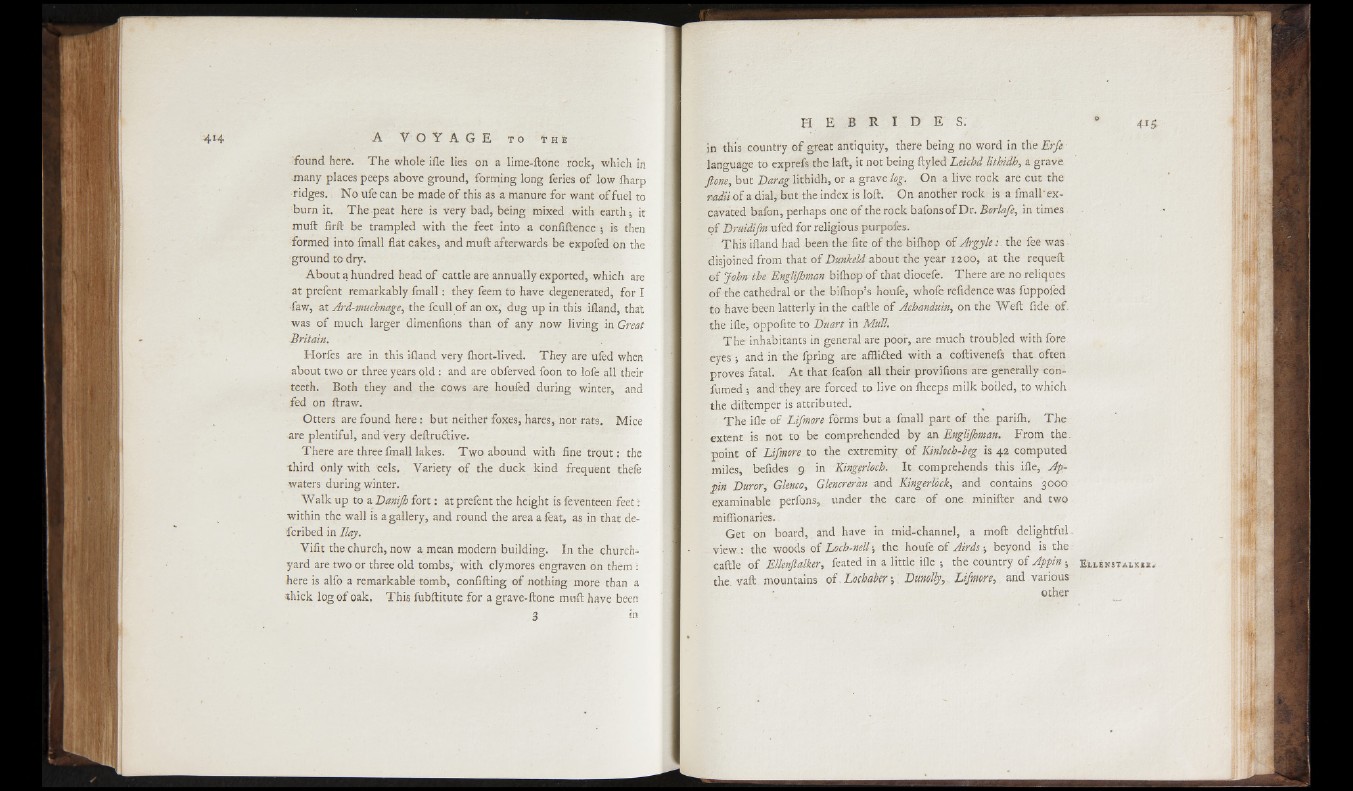
found here. The whole ifle lies on a lime-ftone rock, which in
•many places peeps above ground, forming long feries of low iharp
ridges. No ufe can be made of this as a manure for want o f fuel to
burn it. The peat here is very bad, being mixed with earth; it
mull firft be trampled with the feet into a confiftence ; is then
formed into fmall flat cakes, and muft afterwards be expofed on the
ground to dry.
About a hundred head of cattle are annually exported, which are
at prefent remarkably fmall: they feem to have degenerated, for I
flaw, at Ard-muchnage, the fcull of an ox, dug up in this ifland, that
was of much larger dimenfions than of any now living in Great
Britain.
Horfes are in this ifland very ihort-lived. They are ufed when
about two or three years old : and are obferved foon to lofe all their
teeth. Both they and the cows -are honied during winter* and
fed on ftraw.
Otters are found here: but neither foxes, hares, nor rats. Mice
are plentiful, and very deftrudtive.
There are three fmall lakes. Two abound with fine trout: the
third only with eels. Variety o f the duck kind frequent thefe
waters during winter.
Walk up to a Danijh fo r t: at prefent the height is feventeen feet:
within the wall is a gallery, and round the area a feat, as in that de-
fcribed in Ilay.
Vifit the church, now a mean modern building. In the churchyard
are two or three old tombs, with clymores engraven on them :
■here is alfo a remarkable tomb, confifting of nothing more than a
thick log o f oak. This fubftitute for a grave-ftone muft have been
3 in
in this country of great antiquity, there being no word in the Erfc
language to exprefs the laft, it not being ftyled Leichd litbidh, a grave
ftone, but Darag lithidh, or a grave log. On a live rock are cut the
radii o f a dial, but the index is loft. On another rock is a fmall'excavated
bafon, perhaps one o f the rock bafonsof Dr. Borlafe, in times
of Druidifm ufed for religious purpofes.
This ifland had been the fite of the bilhop of Argyle: the fee was •
disjoined from that o f Drnkeld about the year 1200, at the requeft
of John the Englijhman bilhop o f that diocefe. There are no reliques
of the cathedral or the bilhop’s houfe, whofe refidence was fuppofed
to have been latterly in the caftle o f Achanduin, on the Weft fide of.
the ifle, oppofite to Duart in Mull.
The inhabitants in general are poor, are much troubled with fore
eyes ; and in the fpring are afflidted with a coftivenefs that often
proves fatal. A t that feafon all their provifions are generally con-
fumed ; and'they are forced to live on Iheeps milk boiled, to which
the diftemper is attributed.
The ifle of Lifmore forms but a fmall part o f the. parilh. The
extent is not to be comprehended by an Englijhman. From the
point of Lifmore to the extremity of Kinloch-heg is 42 computed
miles, befxdes 9 in Linger loch. It comprehends this ifle, Ap-
pin Duror, Glenco, Glencreran and Kingerloch, and contains 3000
examinable perfons, under the care o f one. minifter and two
miflionaries.
Get on board, and have in mid-channel,. a moft delightful.
view,: the woods of Loch-nell; the houfe o f Airds * beyond is the
caftle of Ellenftalker, feated in a little ifle ; the country of Appin ; E i u e n s t a l x j e .
the, vaft mountains of Lochahr \ Dunolly, Lifmore, and various
other